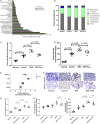High-Fat Diet Induced Gut Microbiota Alterations Associating With Ghrelin/Jak2/Stat3 Up-Regulation to Promote Benign Prostatic Hyperplasia Development
- PMID: 34249898
- PMCID: PMC8264431
- DOI: 10.3389/fcell.2021.615928
High-Fat Diet Induced Gut Microbiota Alterations Associating With Ghrelin/Jak2/Stat3 Up-Regulation to Promote Benign Prostatic Hyperplasia Development
Abstract
The role of high-fat diet (HFD) induced gut microbiota alteration and Ghrelin as well as their correlation in benign prostatic hyperplasia (BPH) were explored in our study. The gut microbiota was analyzed by 16s rRNA sequencing. Ghrelin levels in serum, along with Ghrelin and Ghrelin receptor in prostate tissue of mice and patients with BPH were measured. The effect of Ghrelin on cell proliferation, apoptosis, and induction of BPH in mice was explored. Our results indicated that BPH mice have the highest ratio of Firmicutes and Bacteroidetes induced by HFD, as well as Ghrelin level in serum and prostate tissue was significantly increased compared with control. Elevated Ghrelin content in the serum and prostate tissue of BPH patients was also observed. Ghrelin promotes cell proliferation while inhibiting cell apoptosis of prostate cells. The effect of Ghrelin on enlargement of the prostate was found almost equivalent to that of testosterone propionate (TP) which may be attenuated by Ghrelin receptor antagonist YIL-781. Ghrelin could up-regulate Jak2/pJak2/Stat3/pStat3 expression in vitro and in vivo. Our results suggested that Gut microbiota may associate with Ghrelin which plays an important role in activation of Jak2/Stat3 in BPH development. Gut microbiota and Ghrelin might be pathogenic factors for BPH and could be used as a target for mediation.
Keywords: Ghrelin; Jak2/Stat3; benign prostatic hyperplasia; gut microbiota; metabolic syndrome.
Copyright © 2021 Gu, Liu, Yang, Zhan, Cai, Chen, Chen and Wang.
Conflict of interest statement
The authors declare that the research was conducted in the absence of any commercial or financial relationships that could be construed as a potential conflict of interest.
Figures






Similar articles
-
Alterations of gut microbiota diversity, composition and metabonomics in testosterone-induced benign prostatic hyperplasia rats.Mil Med Res. 2022 Mar 28;9(1):12. doi: 10.1186/s40779-022-00373-4. Mil Med Res. 2022. PMID: 35346378 Free PMC article.
-
Exploring the potential mechanism of Xiaojin Pill therapy for benign prostatic hyperplasia through metabolomics and gut microbiota analysis.Front Microbiol. 2024 Aug 21;15:1431954. doi: 10.3389/fmicb.2024.1431954. eCollection 2024. Front Microbiol. 2024. PMID: 39234552 Free PMC article.
-
Ghrelin Aggravates Prostate Enlargement in Rats with Testosterone-Induced Benign Prostatic Hyperplasia, Stromal Cell Proliferation, and Smooth Muscle Contraction in Human Prostate Tissues.Oxid Med Cell Longev. 2019 Nov 22;2019:4748312. doi: 10.1155/2019/4748312. eCollection 2019. Oxid Med Cell Longev. 2019. PMID: 31885795 Free PMC article.
-
Protective effects of combination of Stauntonia hexaphylla and Cornus officinalis on testosterone-induced benign prostatic hyperplasia through inhibition of 5α- reductase type 2 and induced cell apoptosis.PLoS One. 2020 Aug 13;15(8):e0236879. doi: 10.1371/journal.pone.0236879. eCollection 2020. PLoS One. 2020. PMID: 32790676 Free PMC article.
-
The role of gut microbiota in prostate inflammation and benign prostatic hyperplasia and its therapeutic implications.Heliyon. 2024 Sep 21;10(19):e38302. doi: 10.1016/j.heliyon.2024.e38302. eCollection 2024 Oct 15. Heliyon. 2024. PMID: 39386817 Free PMC article. Review.
Cited by
-
miR-141-3p Regulates the Proliferation and Apoptosis of Endometrial-Myometrial Interface Smooth Muscle Cells in Adenomyosis Via JAK2/STAT3 Pathway.Biochem Genet. 2024 Jun;62(3):2049-2065. doi: 10.1007/s10528-023-10508-4. Epub 2023 Oct 12. Biochem Genet. 2024. PMID: 37828348
-
Alterations of gut microbiota diversity, composition and metabonomics in testosterone-induced benign prostatic hyperplasia rats.Mil Med Res. 2022 Mar 28;9(1):12. doi: 10.1186/s40779-022-00373-4. Mil Med Res. 2022. PMID: 35346378 Free PMC article.
-
Microbiome analysis reveals the inducing effect of Pseudomonas on prostatic hyperplasia via activating NF-κB signalling.Virulence. 2024 Dec;15(1):2313410. doi: 10.1080/21505594.2024.2313410. Epub 2024 Feb 20. Virulence. 2024. PMID: 38378443 Free PMC article.
-
Capsaicin reduces blood glucose and prevents prostate growth by regulating androgen, RAGE/IGF-1/Akt, TGF-β/Smad signalling pathway and reversing epithelial-mesenchymal transition in streptozotocin-induced diabetic mice.Naunyn Schmiedebergs Arch Pharmacol. 2024 Oct;397(10):7659-7671. doi: 10.1007/s00210-024-03092-w. Epub 2024 May 3. Naunyn Schmiedebergs Arch Pharmacol. 2024. PMID: 38700794
-
Neferine attenuates development of testosterone-induced benign prostatic hyperplasia in mice by regulating androgen and TGF-β/Smad signaling pathways.Saudi Pharm J. 2023 Jul;31(7):1219-1228. doi: 10.1016/j.jsps.2023.05.004. Epub 2023 May 11. Saudi Pharm J. 2023. PMID: 37293563 Free PMC article.
References
LinkOut - more resources
Full Text Sources
Miscellaneous

